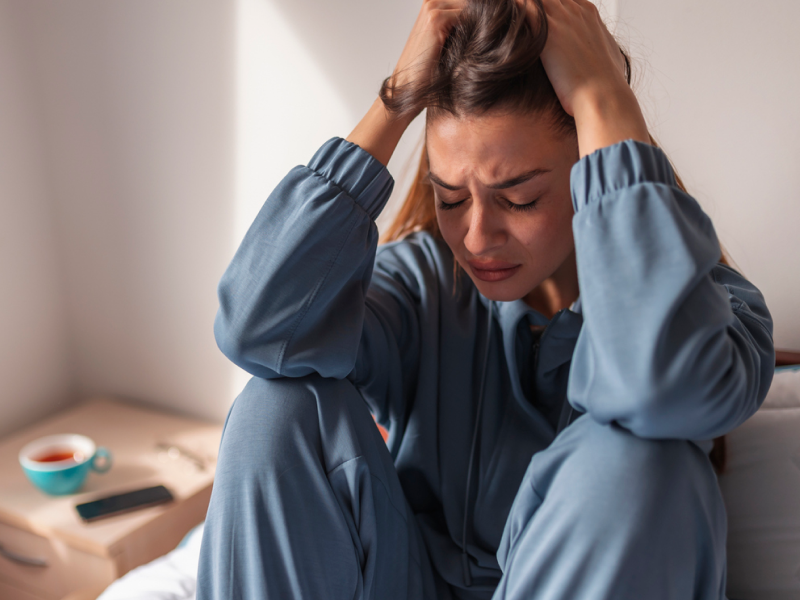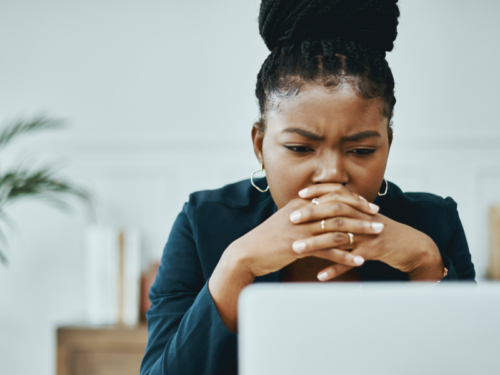
Table of Contents
Silent Anxiety Attacks

Written By: Sarah Fielding

Clinically Reviewed By: Dr. Don Gasparini
June 21, 2023
6 min.
They are a manifestation of anxiety characterized by internal symptoms like dread and dissociation without demonstrating external symptoms.
Learn more about our Clinical Review Process
Table of Contents
When you picture a person experiencing poor mental health, the image in your head will likely include external expressions of distress such as crying, sweating, or shaking — all of which can occur. But, a mental health flare-up or ongoing disorder can present in so many different ways, some of which are intimate and private to the individual. A silent anxiety attack is just that, an experience in which your inside turmoil isn’t clear from the outside.
“Silent anxiety attacks, or ‘quiet’ panic attacks as they’re often called, are a less visible but equally distressing form of anxiety,” says Dr. Ryan Sultan, a psychiatrist and professor of clinical psychiatry at Columbia University. “Unlike the stereotypical depiction of panic attacks involving hyperventilation, heart palpitations, chest pain or other observable symptoms, silent anxiety attacks often manifest as a quiet, internal struggle.”
Individuals who have conditions like generalized anxiety disorder or social anxiety disorders can experience silent anxiety attacks. According to the Centers for Disease Control and Prevention (CDC), about 9.4 million people ages three to 17 were living with diagnosed anxiety between 2016 and 2019. LGBTQIA+ individuals report much higher rates of anxiety. The Trevor Project’s 2022 National Survey on LGBTQ Mental Health found 73% of participants had experienced anxiety, with that number increasing to 79% for pansexual, transgender, and non-binary individuals.
Here’s what you need to know about silent anxiety attacks if you or a young adult in your life has anxiety.
What is it like to have a silent anxiety attack?
A silent anxiety attack means you look completely at ease, but are actually wrestling with anxiety throughout your body and mind. Inside you feel a sea of distress, dissociating from the world around you. Yet, the space you occupy and the people around you are entirely unaware of your anxiety. “The interesting aspect of silent anxiety attacks is that if you’re experiencing one, you might appear entirely composed on the outside, while internally you’re grappling with high levels of anxiety,” says Dr. Raffaello Antonino, a psychologist and founder of Therapy Central and a senior lecturer of counseling psychology at London Metropolitan University.
According to Dr. Sultan, the psychiatrist who teaches at Columbia, common symptoms of silent anxiety attacks include:
- A sense of dread or fear
- Feeling detached or disconnected from reality
- Mental confusion
- Fear of losing control
- Externally calm appearance
Internal physical symptoms like a fast heart rate or upset stomach can also happen during a silent anxiety attack. The inner nature of silent anxiety attacks can make it incredibly difficult for anyone else to notice.

You don’t have to struggle with anxiety alone.
Get started with Charlie Health in as little as 24 hours.
The difference between anxiety and panic attacks
Anxiety and panic attacks often differ in intensity and cause. A panic attack is a more physical, acute experience, often characterized by sweating, shaking, and catastrophic thinking. “Typically, a panic attack leads to an individual’s intense urge to escape whatever situation they find themselves in,” says Dr. Antonino. Panic attacks also occur with less warning and can even happen when a person is awake or asleep.
Steve Carleton, CACIII, a licensed clinical social worker and the executive clinical director at Gallus Detox, a medical detox center, adds that panic attacks also tend to last for a shorter amount of time and have more easily identifiable causes than silent anxiety attacks. “Despite these differences, though, they can still be incredibly disruptive and make it difficult to perform daily activities,” he says. Panic disorder, the form of anxiety most commonly associated with panic attacks, typically first presents in adolescence and, is more often seen in girls.
Causes of silent anxiety attacks
Individuals are more susceptible to having a silent anxiety attack if they live with depression or an overall anxiety disorder. According to Dr. Sultan, an anxiety disorder can occur due to “a complex blend of genetic factors, environmental influences, and personal experiences.” These might include experiencing a traumatic event or having a family member with a mental health condition— though the exact cause of anxiety is still unknown. A silent anxiety attack is made more likely due to this predisposition, with triggers including challenging life events like a job loss or an overwhelming situation.
Silent anxiety attacks, seemingly invisible to the outside world but painful to the individual, serve as a good reminder of why widespread mental health education is so important. Without adults witnessing these internal emotions, a young person must take the initiative to open up and share their symptoms. Silent anxiety attacks are among the various manifestations of mental health disorders that can only be recognized if the person experiencing it has the understanding and words to vocalize how they feel. Often this requires both an understanding of mental health and a feeling that they have a safe space to share what happened without fear of stigma or judgment.
Silent anxiety attacks might prompt concerns about your anxiety and require these open avenues for requesting help. “It’s important to become aware of them and understand them to enable us and our support networks to take the necessary steps towards effective treatment and recovery,” says Dr. Antonino.

How to deal with a silent anxiety attack
Mental health professionals use a combination of therapy, medication, and lifestyle changes to treat silent anxiety attacks, and anxiety in general. “When it comes to treatment, cognitive behavioral therapy (CBT) has shown to be highly effective for anxiety disorders, teaching individuals to identify and change thought patterns that lead to anxiety,” says Dr. Sultan. Cognitive behavioral therapists aim to help you resolve cognitive distortions, which, for people with anxiety, can range from overgeneralizing to catastrophizing. CBT involves identifying negative thoughts and behaviors, recognizing conflicts in your relationships, and improving your confidence in relationships with yourself and others.
Cognitive behavioral therapists can also guide you through different steps to limit silent anxiety attacks and poor mental health as a whole. They might encourage you to face what causes your anxiety (a technique commonly referred to as exposure therapy), practice conversations with loved ones, and try mindfulness or grounding techniques like breathing exercises to ease your anxiety. They might also recommend you visit a primary doctor or psychiatrist who can determine if antidepressants (like selective serotonin reuptake inhibitors) or anti-anxiety medication (like benzodiazepines) could be helpful. Medical professionals can detail the potential benefits of these medications for silent anxiety attacks and any possible side effects.
Practicing meditation or grounding techniques are among the holistic options that can reduce silent anxiety attacks. “Lifestyle changes, such as regular physical exercise, a healthy diet, good sleep hygiene, and mindfulness practices, can be beneficial,” says Dr. Sultan. According to the CDC, children ages six to 12 should sleep between nine and 12 hours each night, and adolescents should sleep eight to ten hours each night. However, the Youth Risk Behavior Survey found that, in 2019, 77.9% of high school students slept less than an average of eight hours on school nights. Evaluating your sleep schedule and making changes when possible to sleep the recommended amount is one of the steps you can take toward reducing silent anxiety attacks.
How Charlie Health can help
Charlie Health’s intensive outpatient program (IOP) utilizes techniques like CBT to support individuals in their exploration and treatment of silent anxiety attacks. Mental health professionals can also guide you in learning and using coping mechanisms to limit and deal with silent anxiety attacks. Learn more about the IOP and available resources here.




